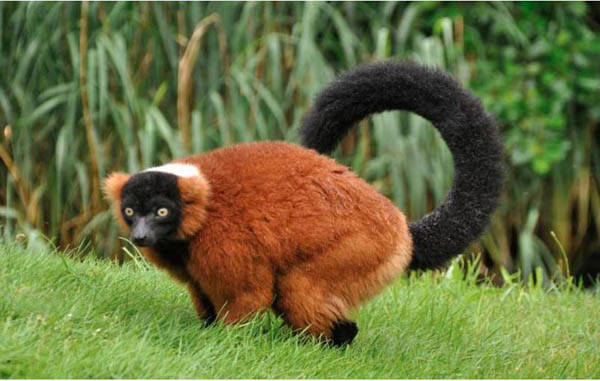Varecia rubra
IUCN
LCBasic Information
Scientific classification
- name:Varecia rubra
- Scientific Name:Varecia rubra,Red Ruffed Lemur
- Outline:Primates
- Family:Lemuridae
Vital signs
- length:55-60cm
- Weight:3.5-4.5kg
- lifetime:15-20years
Feature
Reddish fur, black face, black tail
Distribution and Habitat
The red-collared lemur is a species unique to Madagascar, where it lives in the tropical rainforests in the northeast of the island.
Appearance
The red ruffed lemur is one of the two ruffed lemurs. The head and body length of an adult ruffed lemur is about 55-60 cm, and the tail is the same length. The weight range is 3.5 to 4.5 kg. The fur is reddish, thick, and soft, with white spots on the crown and quite long hair, black face, and black tail.
Details
The red-collared lemur (scientific name: Varecia rubra), whose foreign name is Red Ruffed Lemur, is one of two types of collared lemurs.

Red-collared lemurs generally live in small family-style groups. Groups consist of 2-16 members. Active during the day, active in the early morning and evening. They mostly live in the forest canopy and mainly move on four legs. They walk through the forest habitat, which is a remnant of their original gait. Jumping from one tree to another, they can span significant distances, and often perform vertical climbing and jumping movements. They often squat on the branches of tree trunks when resting. They usually go out alone to forage and then return to the group to sleep.
The mating season of red-collared lemurs is from May to July, and the peak reproduction period is from September to October. Female monkeys give birth in the nest, giving birth to 2-3 offspring per litter, and occasionally up to 6 offspring. Their nests are built in trees 10-20 meters above the ground. Its reproductive habits are quite special. During the non-breeding season, the female monkey's vagina is closed, and the estrus period is only 1-3 days. The mating period is even shorter, limited to 12 hours, and the gestation period is 102 days. Such a short reproductive cycle is not related to the collar. Lemurs are disproportionately large for their size. It may be for this reason that the newborn monkeys are not fully developed yet. The babies, each weighing about 100 grams, have their eyes opened and their hair has grown, but they are extremely weak and unable to grasp the mother's body. Fortunately, the mother monkey always builds a "delivery room" before giving birth. The small nest is made of hay leaves and her own armpit hair, so that the baby monkey can spend the "full moon" comfortably. When it is necessary to move, the mother monkey holds the baby monkey in her mouth. Young monkeys can move around alone after 4 months. During the growth process, nearly 65% of collared lemurs do not live to be 1 year old. The main reasons are death from predators and accidental falls. Life span is between 15-20 years.
Listed in the 2012 Red List of Endangered Species ver 3.1 of the World Conservation Union (IUCN) - Critically Endangered (CR).
Protect wild animals and eliminate wild game.
Maintaining ecological balance is everyone’s responsibility!








